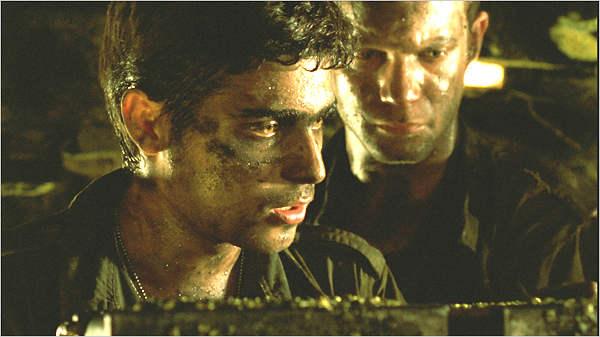Oshri Cohen, left, and Itay Tiran as Israeli soldiers in “Lebanon,” written and directed by Samuel Maoz. Photo credit: Sony Pictures Classics.
I recently saw the film “Lebanon” when it was playing at the West Los Angeles Nuart. To my dismay, it turned out to be the latest example of how hyperbolic stylization and personal narrative are being more commonly used in American and Israeli films in order to shift the focus away from the terrible consequences of waging wars.
The film’s theme is immediately evident: four young, naive Israeli kids are put into a tank with the ostensible task of invading Lebanon. The narrative is based on director Samuel Maoz’s experience as an IDF soldier during the ’82 Israeli invasion. For the duration of the film, the only glimpse of the outside world is through the scope of the tank, and the resulting atmosphere of claustrophobia is sickeningly palpable. According to A.O. Scott, who reviewed the film for The New York Times in August, what viewers saw was essentially a dramatization of “the moral confusion of combat.” For Scott, this ontological quandary is best encapsulated early on in two scenes: the first – wherein the character Shmulik’s hesitation in opening fire on some villagers, who turn out to be militants, results in the death of one of his fellow soldiers, and the second – in which Shmulik finally gets control of his nerve only to end up killing an innocent farmer.
Scott’s interpretation of this is the following: “In a few seconds the young man’s ethical universe has been dismantled and replaced by a cruder set of imperatives: keep moving; do what you can to survive; obey orders; when in doubt, shoot to kill.” In saying this, he is doing exactly what the film is asking him to, namely focusing on the pathos, the tremendous anxiety and inner turmoil of one man, rather than the historical and political context in which the film’s plot actually exists. The problem here is not so much with the director’s sincerity in rendering a formative, and undoubtedly terrible, experience of his life onto the screen, but rather with his use of cinematic technique to trap the viewer into sympathizing with those who would wage war.
That the near complete lack of political context is deliberate makes this look all the more like a public relations film. Maoz was frank about this in an interview: “The mistake I made is to call the film Lebanon because the Lebanon war is no different in its essence from any other war and for me any attempt to be political would have flattened the film.” The ever-perspicacious Slavoj Zizek called this out in a recent column on the London Review of Books website – the film is a personal account, not a rejection of Israeli policy, and this creates a situation in which the viewer does not have to feel responsible for exercising any moral judgment, or for questioning the larger political picture that put these young men in the tank in the first place. Thus, a sort of apology is offered for the actions of the soldiers, and the viewer can more comfortably sympathize with them.
As for the style, throughout my viewing of “Lebanon,” I could not rid myself of the impression that what I was really watching was a war film rendered with all the stylistic complexity of the endless “SAW” flicks that have done such a disservice to the genre of horror cinema over the last few years. The “SAW” movies are slickly-produced but rather unsophisticated in their aims: they seek to cause the viewer extreme discomfort and terror, perhaps as some modern and highly commercialized form of catharsis. Hyper-sensory overload is a common trope in mainstream film these days, indeed it may be even more important than the plot or the screenplay. But to employ this brand of cinematic excess, in which the viewer is strong-armed into being a spectator of horrible events – in this case Israel’s ’82 invasion of Lebanon, which brought about the deaths of tens of thousands of Lebanese – is not only tasteless, but also somewhat offensive. The cloistered atmosphere of the tank and the close-up view through the lens are quite effective in making one squirm in his or her seat, but the pretext of “realism” behind which these elements hide is not valid as an end in itself.
The point of Zizek’s aforementioned critique, not only of “Lebanon” but also other recent likeminded films such as the academy award-wining “The Hurt Locker” and the critically acclaimed “Waltz with Bashir,” is to sift out the disingenuousness that is concealed by refined cinematic flourish. In the case of “Waltz with Bashir” at least, a specific tragedy following the ’82 invasion (during which the Sabra and Chatila massacres were carried out) is the central traumatic event in the story, and the “personal” narrative becomes nearly convincing when coupled with that film’s innovative use of animation. However, the same principle is at work, only in a more complex and evolved artistic format. The lens of the tank through which “Lebanon” is viewed provides a handy illustration of this, since it symbolizes the circumscribed perception of the viewer that is built in to the film. By overly humanizing the perpetrators, the fear and angst transmitted through this lens insure that the viewer will not have too much leeway to consider the even greater suffering of those who were the victims of the invasion, or what the reasons for the invasion even were in the first place.
This article appeared in Al Jadid, Vol. 16, No. 62, 2010.
Copyright © 2010 AL JADID MAGAZINE

